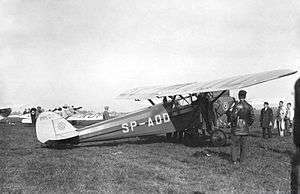PWS-52
| PWS-52 | |
|---|---|
 | |
| Role | Sports aircraft |
| Manufacturer | PWS |
| First flight | July 1930 |
| Retired | 1939 |
| Status | prototype |
| Number built | 1 |
|
| |
The PWS-52 was a Polish sports aircraft of 1930, a single-engine high-wing monoplane, constructed by the Podlaska Wytwórnia Samolotów (PWS), that remained a prototype.
Development
The aircraft was designed in 1929 by Zbysław Ciołkosz and Antoni Uszacki in the Podlaska Wytwórnia Samolotów, specifically to participate in the Challenge international touring aircraft contest (along with PWS-50, PWS-51 and PWS-8). The design was generally modelled after de Havilland Puss Moth. The aircraft was first flown in early July 1930 by Franciszek Rutkowski in Biała Podlaska, weeks before the contest.[1]
Operational history
The prototype, with markings SP-ADD and contest number O8, took part in the Challenge International de Tourisme 1930 contest in 20–31 July 1930, flown by Franciszek Rutkowski. Unfortunately, after landing in Saint-Inglevert, the aircraft was overturned by the wind and was damaged.[2]

After repairs the rudder shape was changed. Later the aircraft took part in some competitions in Poland, with limited success. Among others, flown by Józef Lewoniewski it took the 4th place in the 3rd Polish Light Aircraft Contest in September–October 1930. Lewoniewski then came up with an idea of solo flying the PWS-52 around the world.[1] In 1931 the aircraft was fitted with three extra fuel tanks, giving a maximum capacity 760 l of fuel, which resulted in a range of 4000 km. The aircraft was fitted with a radio and a place for a dinghy. The rudder shape changed again, and the engine DH Gipsy I (85 HP) was changed to DH Gipsy III (120 hp), altering the aircraft's nose. Its maximum take-off weight rose to 1160 kg (with empty weight of 480 kg).[1]
The modified aircraft was ready in April 1931, and Lewoniewski flew it around Poland on 15 August 1931, on a distance of 1755 km without landing, with one passenger. On 1 September 1931 Lewoniewski flew the aircraft from Warsaw to Saloniki and back (2700 km). On the way, he had to land in Hungary and Greece due to engine faults. Lack of funds and problems of the PWS factory caused the plan to fly around the world to be abandoned.[1]
In 1937 the aircraft was bought by a private owner from the PWS Aviation Club, who dismounted the extra tanks and used it in a sports aviation. The plane crashed in 1939 during a training flight.[1]
Description
The PWS-52 was single-engine mixed construction braced high-wing monoplane. A fuselage was built on a steel frame, covered with canvas and aluminium in engine part. Rectangular three-section wings with rounded tips, two-spar, were covered with plywood in forward part and canvas in a rear part. A central part of wings was some distance above the canopy, supported with struts.[1] Side sections of wings were supported with V struts and folds rearwards. The aircraft can seat two, sitting side by side in a covered cockpit. A luggage compartment was behind a cockpit, that could fitted with a 3rd seat. The PWS-52 had a fixed conventional landing gear, with a rear skid.
The aircraft used 4-cylinder air-cooled straight engine de Havilland Gipsy I in front, 85/95 hp nominal/take-off power, later replaced with de Havilland Gipsy III, 120 hp, with two-blade wooden propeller of a fixed pitch. Fuel tank (170 l capacity) is placed in a central wing section (normal amount of fuel - 90 l). Fuel consumption rate is 25 l/hour (Gipsy I) or 28 l/hour (Gipsy III).[1]
Specifications
Data from Glass, A. Polskie konstrukcje lotnicze 1893-1939
General characteristics
- Crew: 1, pilot
- Capacity: 1-2
- Length: 7.53 m ()
- Wingspan: 11.52 m ()
- Height: 2.39 m ()
- Wing area: 19.5 m² ()
- Empty weight: 439 kg ()
- Useful load: 216 kg (max. 389 kg) ()
- Loaded weight: 655 kg ()
- Max. takeoff weight: 828 kg ()
- Powerplant: 1 × de Havilland Gipsy I 4-cylinder air-cooled straight engine, 95 hp ()
Performance
- Maximum speed: 170 km/h
- Cruise speed: 140 km/h
- Stall speed: 73 km/h ()
- Range: 480-760 km ()
- Service ceiling: 3,200 m ()
- Rate of climb: 2.6 m/s ()
- Wing loading: 33.5 kg/m² (lb/ft²)
See also
- Aircraft of comparable role, configuration and era
References
- (Polish) Andrzej Glass, Polskie konstrukcje lotnicze 1893-1939 [Polish aviation constructions 1893-1939], WKiŁ, Warsaw 1977 (no ISBN), pp. 188–190.
External links
| Wikimedia Commons has media related to PWS-52. |